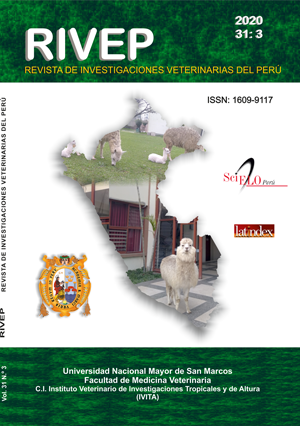Keeping backyard animals and evaluation of knowledge and practices associated with exposure to zoonotic agents in La Coipa, Cajamarca, Peru
DOI:
https://doi.org/10.15381/rivep.v31i3.18733Keywords:
animal husbandry, animal diseases, preventive medicine, public healthAbstract
The aim of this study was to describe the characteristics of keeping backyard animals and describe the knowledge and practices associated with exposure to zoonotic agents among residents of the La Coipa district, Cajamarca, Peru in 2019. A cross-sectional study was designed based on a survey to collect information on the ownership, type and quantity of animals, as well as knowledge and practices related to exposure to zoonotic agents. In total, 280 people from urban areas (46.4%) and rural areas (53.6%) were interviewed. It was reported that 66.8% had poultry, 28.6% guinea pigs, 20.7% equines, 15.7% pigs, 2.5% bovines and 0.7% rabbits, their main utility being self-consumption, except for equines that were used as draft animals. Knowledge about the animal involved in the transmission of cysticercosis was high (75%), but it was low for fascioliasis (10.4%) and hydatidosis (1.1%). Besides, 11% said that they have seen hydatid cysts in animal viscera, 59.6% cysticercosis in pig meat and 10.4% fasciola in livers. The removal of organs or affected meat was the most frequent practice. There is a perceived need to train animal breeders to maximize production and decrease the risk of exposure to zoonoses.
Downloads
Downloads
Published
Issue
Section
License
Copyright (c) 2020 Vilma Alberca Castillo, Daphne León Córdova, Néstor Falcón Pérez

This work is licensed under a Creative Commons Attribution-NonCommercial-ShareAlike 4.0 International License.
AUTHORS RETAIN THEIR RIGHTS:
a. Authors retain their trade mark rights and patent, and also on any process or procedure described in the article.
b. Authors retain their right to share, copy, distribute, perform and publicly communicate their article (eg, to place their article in an institutional repository or publish it in a book), with an acknowledgment of its initial publication in the Revista de Investigaciones Veterinarias del Perú (RIVEP).
c. Authors retain theirs right to make a subsequent publication of their work, to use the article or any part thereof (eg a compilation of his papers, lecture notes, thesis, or a book), always indicating the source of publication (the originator of the work, journal, volume, number and date).



